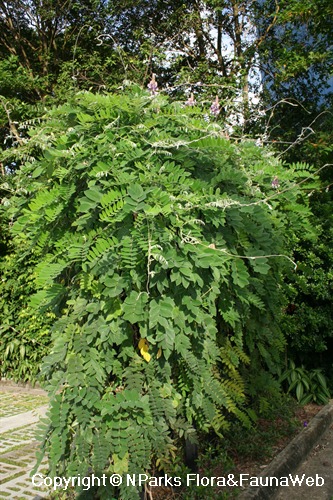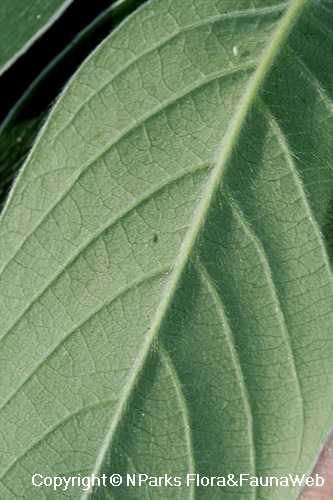
Back
Afgekia mahidoliae B.L. Burtt & Chermsir.
| Family Name: | Fabaceae (Leguminosae) |
| Common Name: | Kan Phai Mahidol, Purple Afgekia |
Name
Classifications and Characteristics
| Plant Division | Angiosperms (Flowering Seed Plants) (Dicotyledon) |
|---|---|
| Plant Growth Form | Climber |
| Lifespan (in Singapore) | Perennial |
| Mode of Nutrition | Autotrophic |
| Plant Shape | Shrubby |
| Maximum Height | 5 m to 10 m |
Biogeography
| Native Distribution | Western Thailand |
|---|---|
| Native Habitat | Terrestrial (Monsoon Forest) |
| Preferred Climate Zone | Sub-Tropical / Monsoonal |
Description and Ethnobotany
| Growth Form | Bushy evergreen leguminous vine with slender woody stems at base, climbing up to 10m height with support. |
|---|---|
| Foliage | Leaves odd-pinnately compound, with 11 opposite leaflets per leaf. Leaflets broadly-oval (7.5cm by 4.3 cm), soft, densely pubescent on both surfaces and along margins, appearing silvery-green on top and pale green below. Young leaflets densely furry, appearing silver-white before unfolding, produced on tomentose twining stems. |
| Flowers | Papilionoid (pea-like), with 5 furry-pubescent purple-white petals -- 1 purple upper-petal ("standard") with pink-yellow nectar guide, 2 purple lateral-petals ("wings") that form a cap over 2 white lower-petals ("keel"), which in turn enclose the reproductive parts within a boat-like structure. Inflorescences raceme, long and many floreted, upper portion purplish-yellow, generally produced near top of plant. Florets open gradually from base to tip of inforescence over a long period, although each floret lasts only for 1 day. Flowering occurs from August to November in native range, but plant is probably quite free-flowering year-round outside of natural habitat, as observed in other cultivated sites in Thailand and Singapore. |
| Fruit | Clustered seedpods, generally produced in low quantities, not commonly seen outside of native range in western Thailand. Fruiting not observed in Singapore. |
| Habitat | Narrowly endemic to western Thailand, found in mixed deciduous forests on limestone hills, first discovered at Sai Yok, Kanchanaburi in 1967 by Thai botanist Kasem Chandraprasong. Species relatively rare, currently threatened by habitat loss, low population densities and difficulty in sexually propagating itself. |
| Similar | Closely resembles Afgekia sericea (Silky Afgekia) -- which can be differentiated by its pink-white inflorescences, as well as smaller and elliptical leaflets (6.5cm by 2.5 cm, 15-17 per leaf) that are even more tomentose and more silvery-white below. |
| Cultivation | Fuss-free and relatively free from pests. Provide regular moisture. Tolerant of alkaline soils. Can be grown as a potted plant by twining the stems around stakes. Propagate by seed (if available), as cuttings appear to be difficult to strike. |
| Etymology | Genus epithet "Afgekia" derived from the name initials of Irish medical doctor and plant-collector Arthur Francis George Kerr (1877-1942), who worked on the taxonomy of Thai flora from 1925 to 1931. Species epithet originally published by Burtt and Chermsirivathana in 1971 as “mahidolae”, whose spelling was recently revised to the current "mahidoliae", as based on the latest version of the International Code of Botanical Nomenclature (ICBN Vienna code, Recommendation 60C.1.b.) Species epithet "mahidoliae" named in honour of late King Bhumibol Adulyadej's mother, the Princess Mother Somdej Phra Sri Nakarindra Boromarajajonnani (then Princess Srisangwan Mahidol, wife of Prince Mahidol of Songkla). (Note:- "Mahidol" is pronounced "Mahidon", as the Thai language lacks a pronunciation for the -ol ending.) Prefix of vernacular name "Kan Phai Mahidol" is derived from "Kan Phai" -- a Thai term meaning "protecting from threat", and which is represented as a captivating benovelent vine in Thai religious sacraments. Species adopted by Thailand's Mahidol University as its symbolic plant. |
| Ethnobotanical Uses | Others: Plant is being investigated for its potential medicinal properties and applications. Antioxidants previously isolated from leaf extracts. |
Landscaping Features
| Desirable Plant Features | Ornamental Foliage, Ornamental Flowers |
|---|---|
| Landscape Uses | Vertical Greenery / Green Wall, Container Planting |
| Thematic Landscaping | Silver Garden, Naturalistic Garden |
Fauna, Pollination and Dispersal
| Pollination Method(s) | Biotic (Fauna) (Insects (Bee)) |
|---|
Plant Care and Propagation
| Light Preference | Full Sun |
|---|---|
| Water Preference | Moderate Water |
| Plant Growth Rate | Moderate |
| Rootzone Tolerance | Fertile Loamy Soils, Well-Drained Soils, Alkaline high pH Soils |
| Maintenance Requirements | Moderate |
| Propagation Method | Stem Cutting |
Foliar
| Foliage Retention | Evergreen |
|---|---|
| Mature Foliage Colour(s) | Green, Silver / Grey |
| Mature Foliage Texture(s) | Velvety / Furry / Tomentose, Hairy / Hirsute, Raised / Sunken Veins |
| Foliar Type | Compound (Odd-Pinnate) |
| Foliar Arrangement Along Stem | Opposite |
| Foliar Shape(s) | Non-Palm Foliage (Oval) |
| Foliar Venation | Pinnate / Net |
| Foliar Margin | Entire |
| Foliar Apex - Tip | Mucronate |
| Foliar Base | Rounded / Obtuse |
| Typical Foliar Area | Notophyll ( 20.25cm2 - 45 cm2 ) |
| Prominent Young Flush Colour(s) Remarks | Silver, White |
Non - Foliar and Storage
| Stem Type & Modification | Woody, Herbaceous |
|---|---|
| Root Type | Underground (Fibrous Root) |
Floral (Angiosperm)
| Flower & Plant Sexuality | Bisexual Flowers |
| Flower Colour(s) | Purple, White, Yellow / Golden |
|---|---|
| Flower Symmetry | Bilateral |
| Individual Flower Shape | Papilionaceous / Pea-shaped |
| Inflorescence Type | Raceme |
| Flowering Period | Free-Flowering |
| Flowering Opening Time | Daytime |
| Flower Lifespan on Plant | 1 Day |
| Flowering Habit | Polycarpic |
Fruit, Seed and Spore
| Fruit Classification | Simple Fruit |
|---|---|
| Fruit Type | Dehiscent Dry Fruit , Legume / Pod |
Image Repository
Others
| Master ID | 29169 |
|---|---|
| Species ID | 3478 |
| Flora Disclaimer | The information in this website has been compiled from reliable sources, such as reference works on medicinal plants. It is not a substitute for medical advice or treatment and NParks does not purport to provide any medical advice. Readers should always consult his/her physician before using or consuming a plant for medicinal purposes. |

























